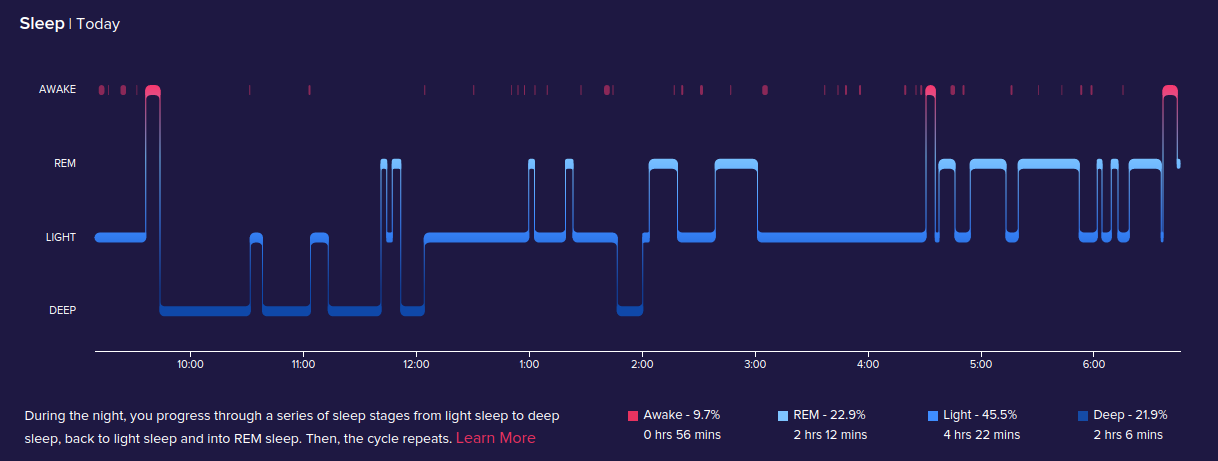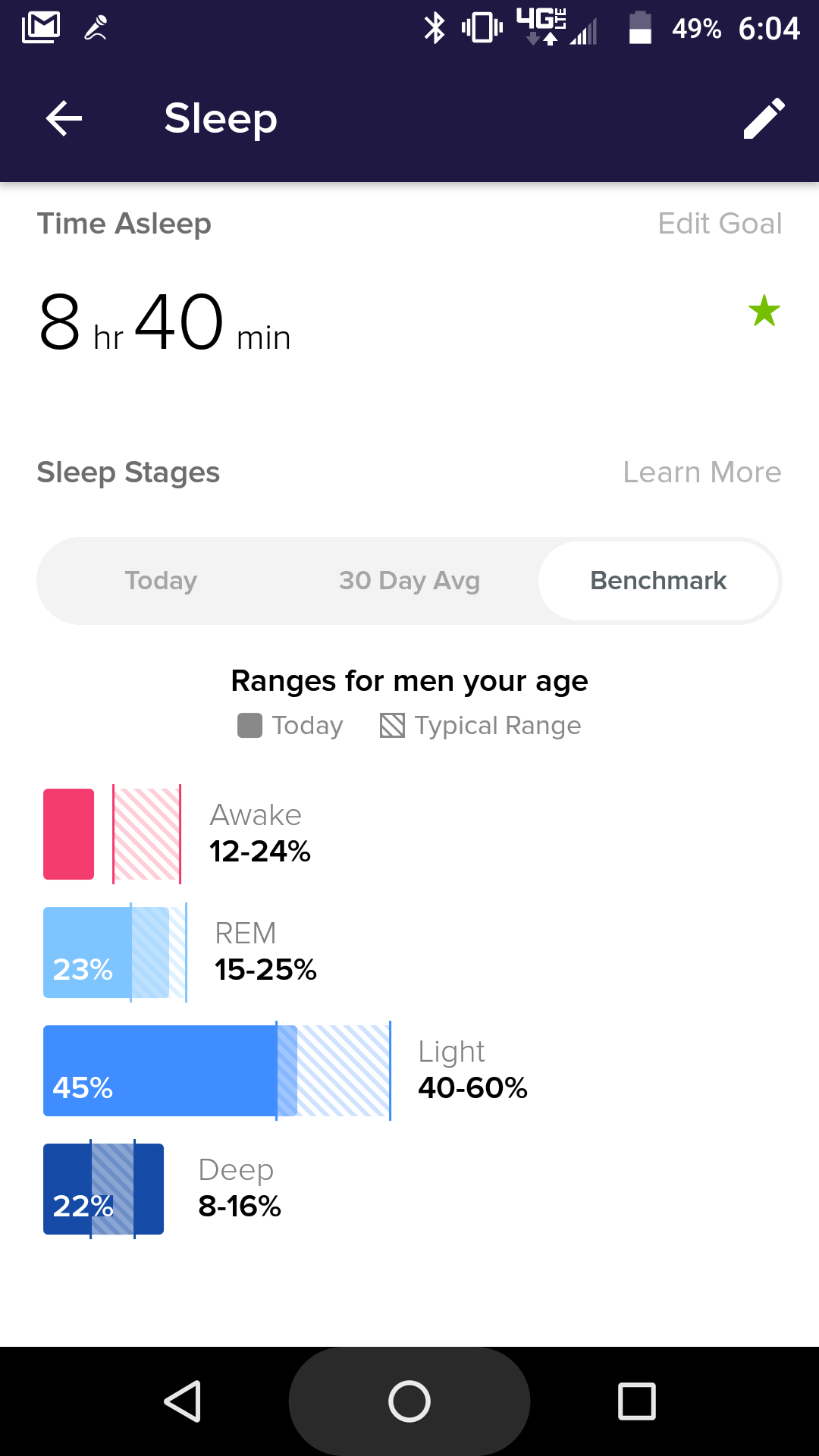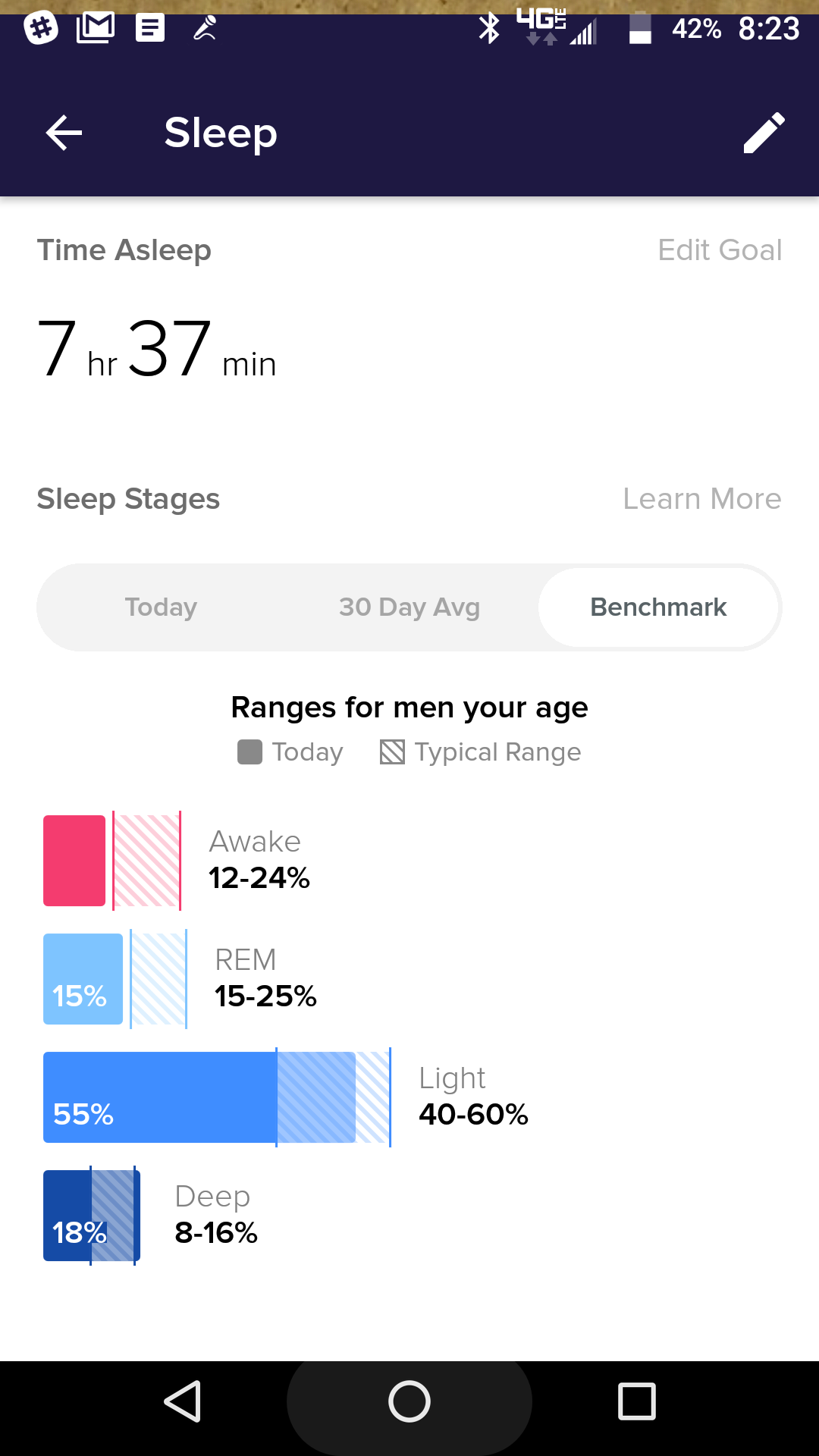Fitbit just upgraded its sleep tracker. Using data from your heart rate, breathing and movements, it calculates when you’re in light, deep and REM sleep.
Given the massive impact that sleep stages and quality have on learning, mood, weight, memory, Alzheimer’s and sanity, the implications of Fitbit’s new feature are huge.
Here’s an example of my own graph, made with data from my Fitbit Charge 2, for a recent night.

From bottom to top: deep sleep, light, REM, then blips of wakefulness in red. Read left to right, the tracker shows more periods of deep sleep early in the night, followed by more medium sleep, then more REM.
Fitbit also graphs how your sleep stages stack up versus other people your sex and age. (At present, this benchmarking only seems to be accessible via their mobile interface.) Here’s what that looks like for me:


As you can see in these two example graphs, my proportion of deep and REM sleep seem lower after I’ve had three beers. I’m going to keep an eye out going forward and see if this correlation is born out.
Beyond my personal beer puzzle, imagine what we’ll learn as warehouses worth of enhanced sleep data like get integrated into drug trials, therapy, physical exams, coaching, research and even education.
If I were Fitbit’s CEO, here’s other functions I’d be funding in the company’s R&D pipeline:
- integration of a UV monitor to remind you that, like most Americans, you’re not getting enough essential sunjuice to avoid depression, diabetes and sex hormones
- a feature that tracks (and benchmarks versus happy peers) how much you’re peering into your phone, thereby missing out on the glorious people and nature all around you
- a feature that tracks impact force, since more force seems to correlate with higher bone density
- a sweat monitor to detect variations in minerals and salts
- some randomly timed, simple questions about mood and focus (as in this temporary app built by researchers)
- a way to log physical inputs/outputs like meal times, alcohol consumption, medications, BMs
- a way to annotate the chronological feed, labeling periods of socializing, reading, working
As Fitbit’s CEO, I’d also borrow a page from Apple’s playbook and try to nuture a robust health app store, opening up the Fitbit API (data relating to heart rate is currently still restricted) to allow software geniuses to breed a zoo’s worth of new meters, games and notifications. Anyone want to race me to 100 hours of REM sleep? What about a dating service based on sleep-quality? Or academic coaching: “Hey Joe, use an 8am dose of sunlight followed by 30 minutes of running to boost your deep sleep ratio by 30% and pull your history grade up to an A.”
Looking beyond Fitbit, the cost of gathering, storing and analyzing personal health data is in the midst of dropping 99.999%. The health care ramifications are huge as we experience an exponential expansion of benchmarking and diagnostics at the personal and population level.
We’ll travel far beyond medicine’s current state of the art, in which a handful of patients in a study funded by a drug company can determine a treatment regime affecting millions of vulnerable people. We’ll some day view the current prescription regime for powerful neurotripic drugs like SSRIs — with a less-than-50% success rate for depression, a sketchy understanding the drugs’ actual neural mechanics and sometimes-disasterous side effects — to be as crude as the lobotomy craze of the middle of the last century.
We all know that after 100 years of co-evolution in the US, the medical-industrial complex (MIC) — nurses, clinics, hospitals, doctors, insurance companies, drug companies, med schools, government regulations and agencies — is a quagmire. Meanwhile, autonomous, bottom up technology and algorithms will rocket ahead, powered by compounding daily innovations in systems, forces and resources. These include:
- giant data sets from sources like Fitbit, 23andme and PatientslikeMe
- AI services like Watson and AlphaGo
- fMRIs, which provide increasingly detailed snapshots of brain activity
- online knowledge hubs about specific DNA mutations (example mthfr)
- real-time personal data from wearables
- cheap and robust 3D printing
- bio hackers (see this $400 printable 35-node EEG/ECG rig)
- Arduinos
- frenzied entrepreneurial iterating
The history of computers offers a sense of the trajectory ahead. While in 1950 there were hundreds of computers in the United States, today the hundreds of computers within 100 feet of your bedroom are each 10,000X more powerful than 1950’s biggest. Put all these forces together and Moore’s Law — the doubling-every-18 months pace at which chip memory grew — will soon look like buggy speed.
——————————–
More resources:
- Great video overview of research on sleep, learning and aging, with a cool detour into neuro-hacking and a revealing sequence of interviews during a student’s all nighter. And a deeper dive by the same guy.
- Here’s a Dartmouth College proof-of-concept study that successfully predicted student GPA’s based on phone movements, which included a crude proxy for sleep duration.
- Looks like lots of Fitbit owners on this Reddit thread still don’t have the ‘stages’ functionality. Since the feature seems to depend on vagal tone, which is fainter in folks who don’t exercise a lot, I wonder if, for some folks, the sleep stages feature will never work.
- Sleeping shorter or later correlates with more rumination, a building-block of depression.
- Good overview (from ’08!) of the fact that AI and deep data will outperform theory.

